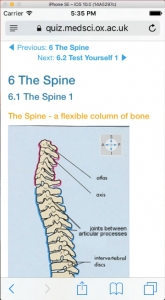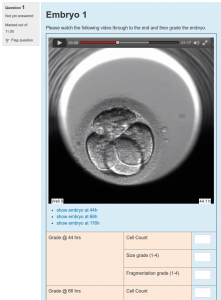In an earlier post I outlined plans for migration of MedLearn to Moodle. The technical work is now done except for editor plugins. The migration is well underway.
The tricky bit was getting the self test questions to work. The purpose of self test questions is to enliven content and enhance learning. They are not intended to be an assessment, although it may be useful to record the answers.
The Quiz activity provides the best range of question types but it also forces questions into an assessment with a very specific workflow (start attempt; answer questions; finish; submit; review). We wanted a much looser workflow which did not present questions as a quiz. The answer (suggested by Tim Hunt) was to embed a preview question in an iFrame. We chose the Book module for the content into which the questions were embedded.
Students log in to our VLE (Sakai). They then launch an LTI tool which automatically provisions them in Moodle. They are assigned an adapted set of permissions to avoid the issues highlighted by Tim Hunt in this post. The LTI provider plugin does all the provisioning, including the assignment of the role with the permissions.
Questions are inserted into the book content using Generico filter and Atto plugin. I’ve defined a template which just takes the question number and applies the correct iFrame. A Javascript frame resize script triggers on load (and on change) so that the question appears seamlessly in the content. The plugin also has an Atto editor plugin to simplify editing.
I have modified the preview PHP so that the title and config have been stripped off, leaving just bare question with answer box and ‘check’ button. The preview PHP still accepts the querystring configuration so I passed &correctness=0&marks=0&markdp=0&feedback=1&generalfeedback=1&rightanswer=1&history=0 to it in the Generico template.
The script tag to load the JavaScript resize code is in AdditionalHTML config.
We’ve also made the content more mobile friendly using Bas Brand’s Bootstrap 3 theme and more semantically relevant HTML5 tags such as <figure>, <cite>, <dfn> and <dl>. We are about to start authoring Atto plugins to support these tags. JQuery is used to for image swaps, replacing the mouseovers and flash which aren’t mobile friendly.
The only missing feature which would be really nice to have is a way of browsing the questions from the question bank for insertion. It’s currently a little clunky to find the question ID for use in the Generico Atto plugin.
My thanks go to Tim Hunt, Juan Leyva (LTI Provider) and Justin Hunt (Generico) for making the tools which underpin this integration.




